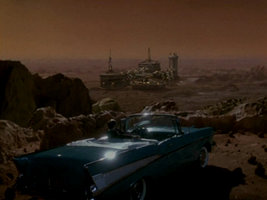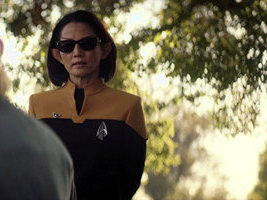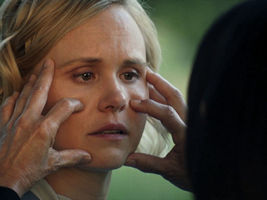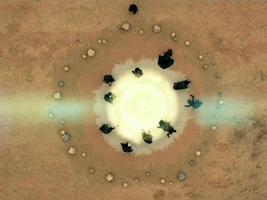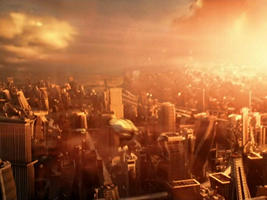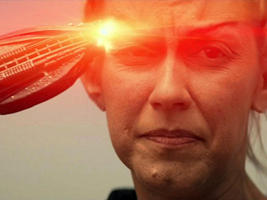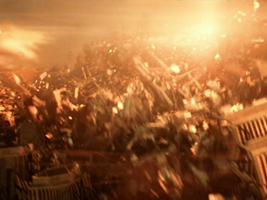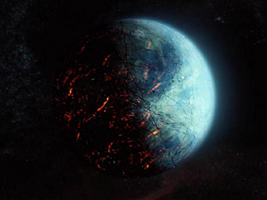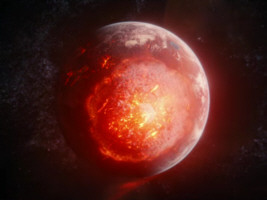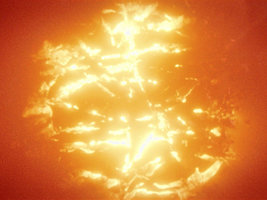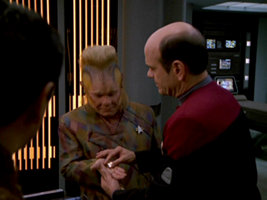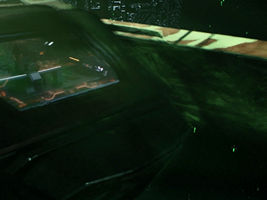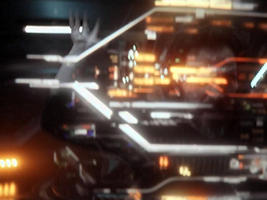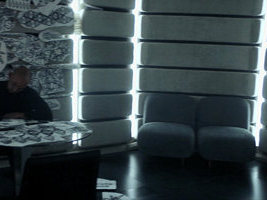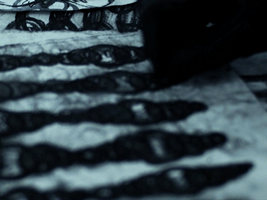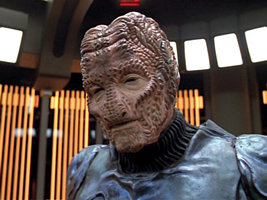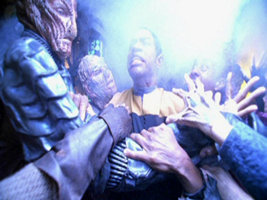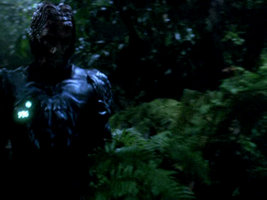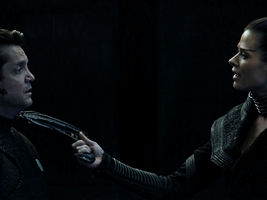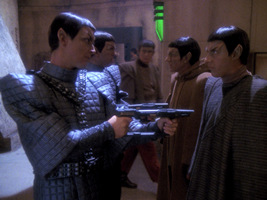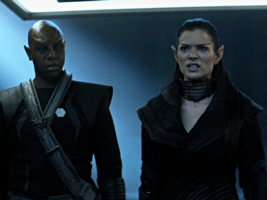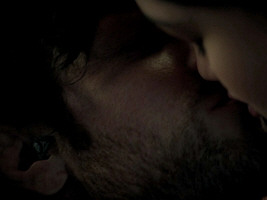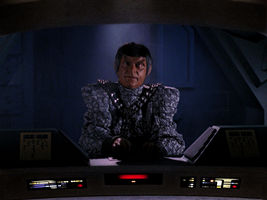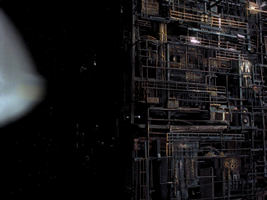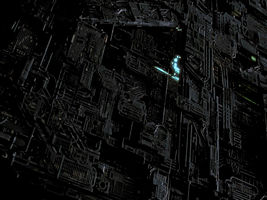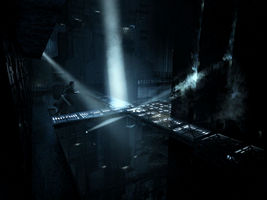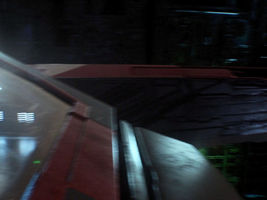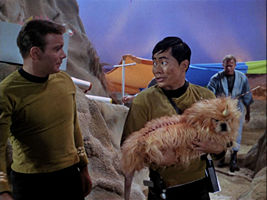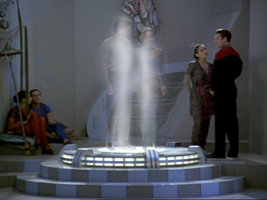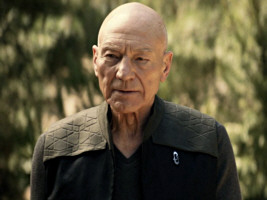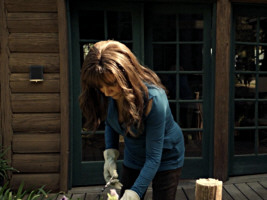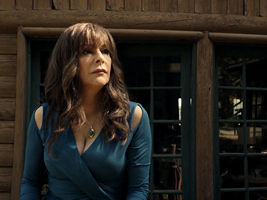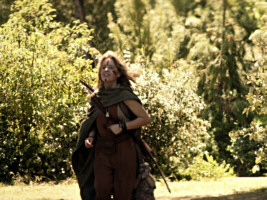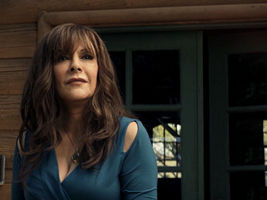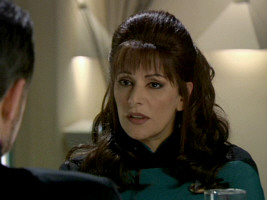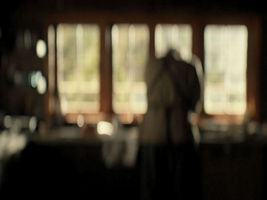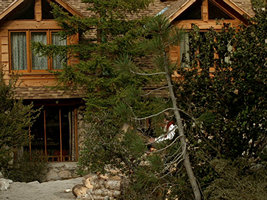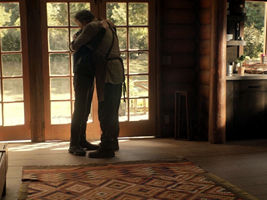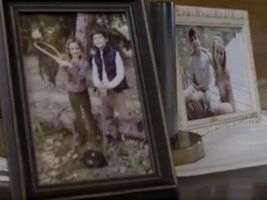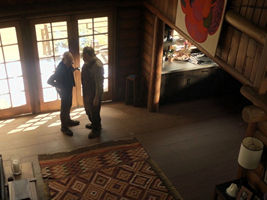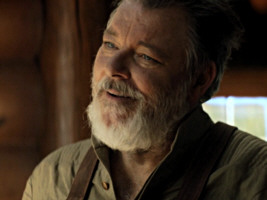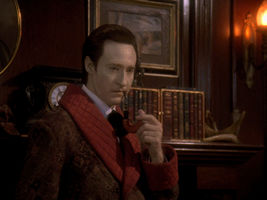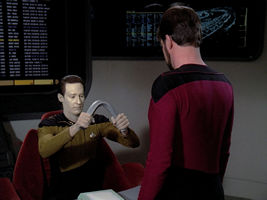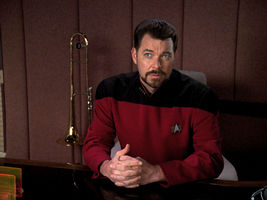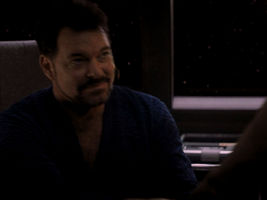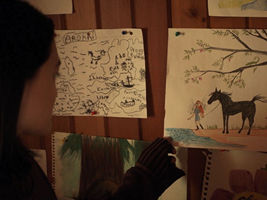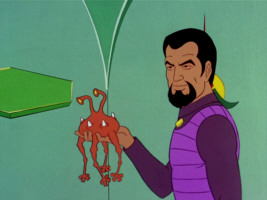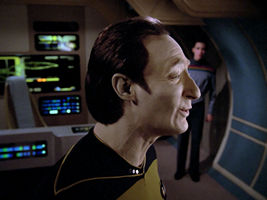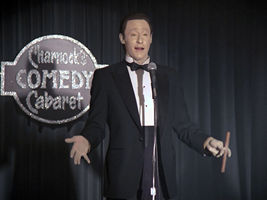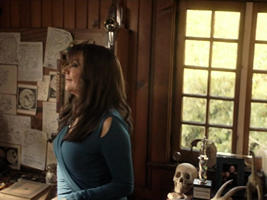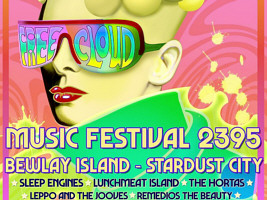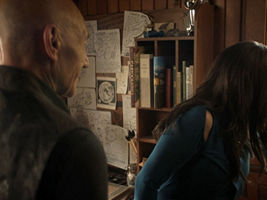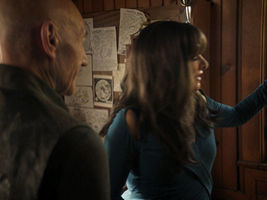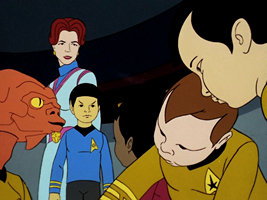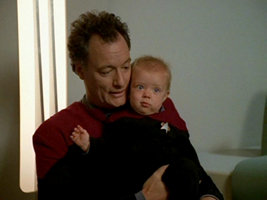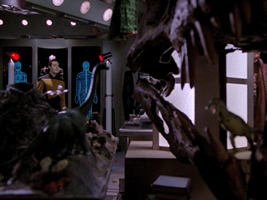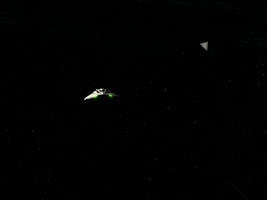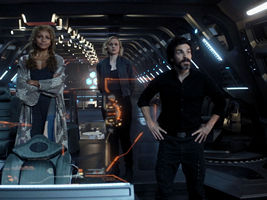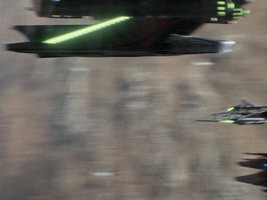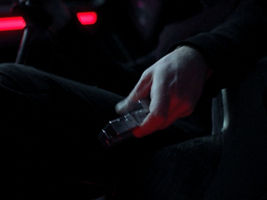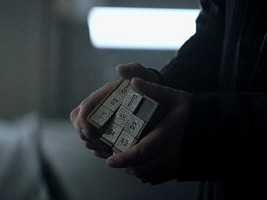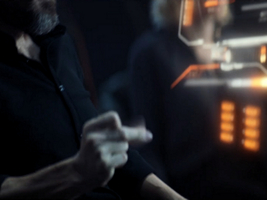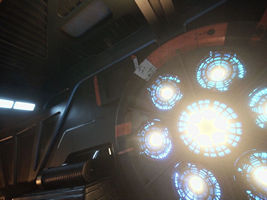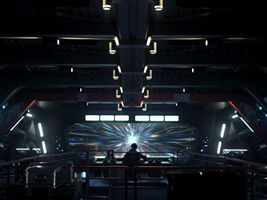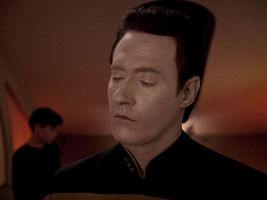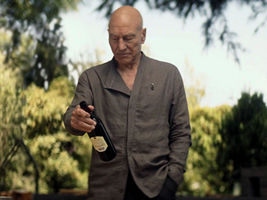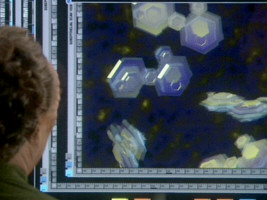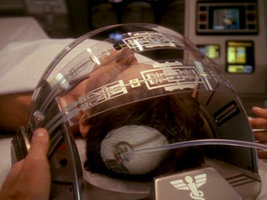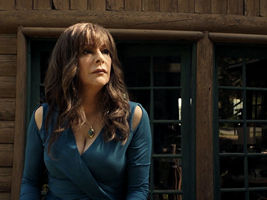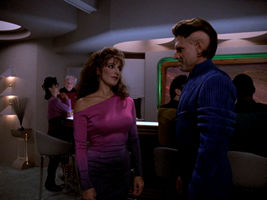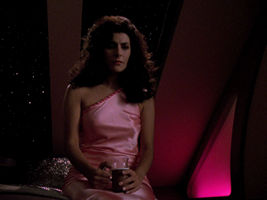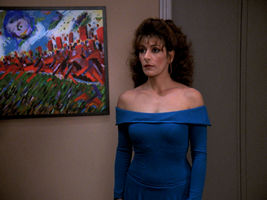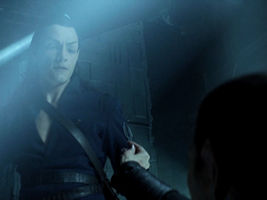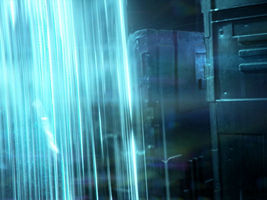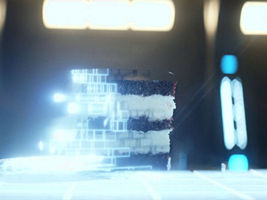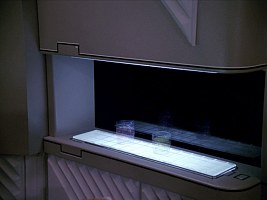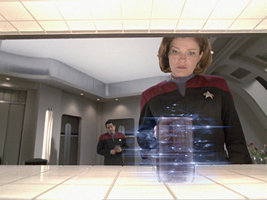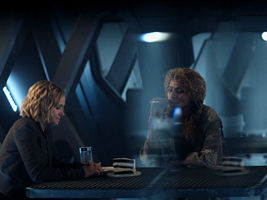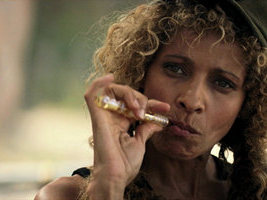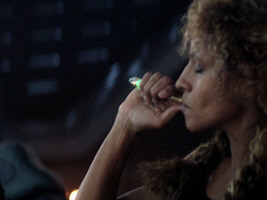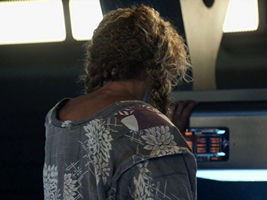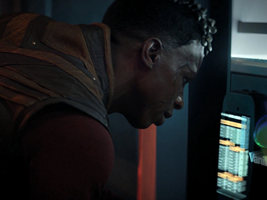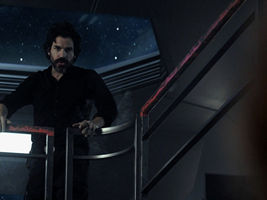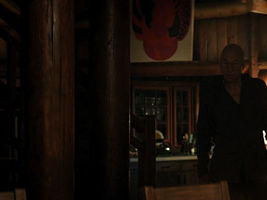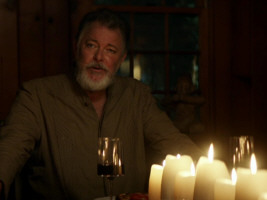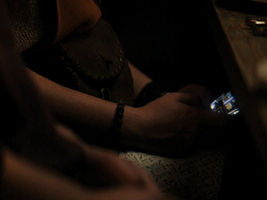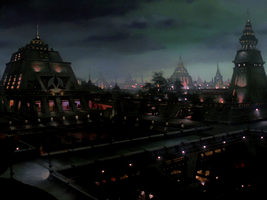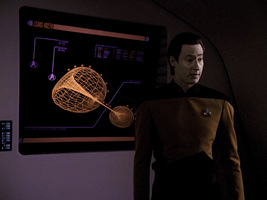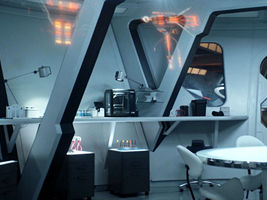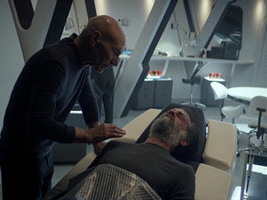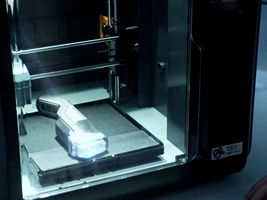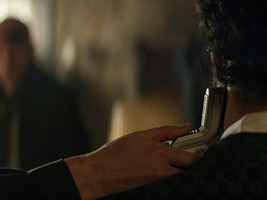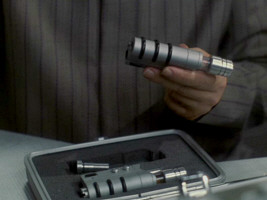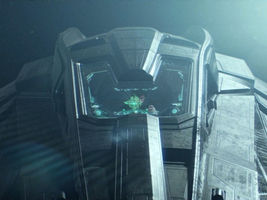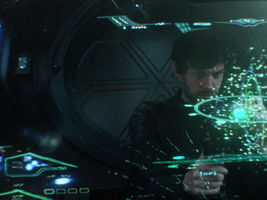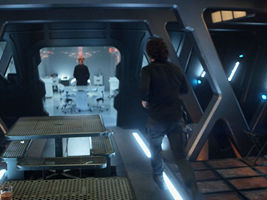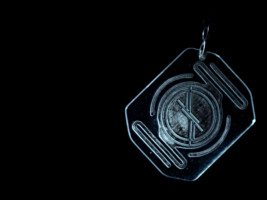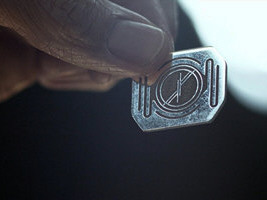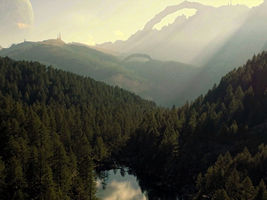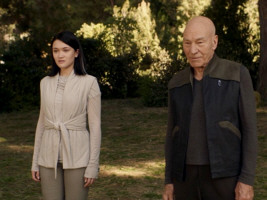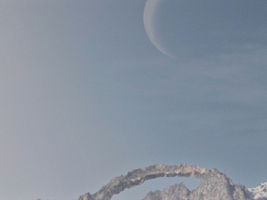Observations in PIC: "Nepenthe"
by Jörg Hillebrand and Bernd Schneider
Here are some observations about sets, props, make-ups and visual effects in PIC: "Nepenthe", with special attention to continuity with previous Star Trek series and movies.
Chronological List
Observation 01
For some reason, the footage of the two moons Soji sees through the skylight in her dream has changed appearance since the last episode. In the recap, the moons now appear larger, have changed position and the clouds and lightning are now a much more reddish hue. Also, the clouds at the center of the image look more menacing now.
Observation 02
In a flashback to "The End is the Beginning", the Daystrom Institute in Okinawa is seen again. The structure in the background of the first screen cap is similar to the main building of the Institute as in "Remembrance". As that building was located on the other side of the bay, this must be a separate second building on the extended campus of the Institute.
The second cap shows that in comparison to "The End is the Beginning", a shuttle was removed from the footage for "Nepenthe".
Observation 03
The earbuds Dr. Jurati uses to listen to Kasseelian opera can be seen in this shot. In "The End is the Beginning", they were not really visible.
Observation 04
Round buildings like the one on the cliff in this shot were also seen on the surface of Mars in "Lifesigns".
Observation 05
Even in the new footage not already known from "The End is the Beginning", Commodore Oh's rank pin is out of alignment.
Observation 06
Commodore Oh rather forcefully performs a two-handed Vulcan mind meld on Dr. Jurati. The Vulcan mind meld was first seen in the TOS episode "Dagger of the Mind" when Spock performed it on Dr. Simon Van Gelder.
Observation 07
Several images appear during the mind meld between Commodore Oh and Dr. Jurati. As we learn in "Broken Pieces" (where the footage reappears with several changes), this is the "Admonition".
- The first pictures show Oh wearing a hooded robe and hooded figures standing in a stone circle.
- This shot of an exploding planet was originally created for the mind meld scene in "If Memory Serves". It show the destruction of Earth. The footage was modified for this re-use however, as the moon was removed from the footage and more impact craters were added.
- A Vulcan or Romulan in agony.
- An apparently new shot of an exploding planet.
- A Vulcan or Romulan in agony.
- A city gets destroyed, including a Discovery-type shuttlecraft flying towards the camera.
- A Romulan, killing herself with a Romulan disruptor pistol.
- The destroyed city again.
- These shots were originally created for the mind meld scene in DIS: "If Memory Serves", where they showed the destruction of Vulcan. Only the starry background and the effect of the shattering crust of the planet is re-used in "Nepenthe". The planet itself is completely different as the reddish hue of Vulcan didn't fit the blue appearance of Earth needed for "Nepenthe". In this episode, all shots of exploding planets are most likely supposed to show Earth.
Observation 08
The tracker Oh gives to Jurati is suspended in what looks like a fancy cough drop. In the past, transponders like this tracking device were usually implanted under the skin in such episodes as "Birthright II" (the tracker was made from boridium in that case and injected with a Romulan injector) and "Workforce I". We will learn in the following episode, "Broken Pieces", that the substance Jurati ingested is viridium. The viridium patch in "Star Trek: The Undiscovered Country", in contrast, was quite conspicuous.
Observation 09
La Sirena is caught in a green tractor beam. Both Romulan (TNG: "The Mind's Eye") and Borg (TNG: "Q Who") tractor beams were shown to be green in the past.
On the very left of the first cap, there is some kind of organic shape that could be a depiction of a mermaid. In "Et in Arcadia Ego I", we will see this nose art very clearly.
Observation 10
Rios' cigar cutter is jumping up and down as La Sirena tries to escape the tractor beam.
Observation 11
Rios slams into the holographic controls showing that, most likely using force fields, the interfaces are tactile and not just visual.
Observation 12
As Raffi is hacking the traffic control system of the Artifact, she sees images of the paintings drawn by the Romulan disordered in "The End is the Beginning". While the images are visible, she makes a reference to "freaky Borg machine language".
Observation 13
One of the xBs (the one Narissa kills first) may be a Hirogen. Hirogen that were assimilated by the Borg appeared in two Voyager episodes, namely "Infinite Regress" and "Unimatrix Zero II". In both cases, they were not seen assimilated but in their natural state, namely in Seven's mind and in Unimatrix Zero.
Observation 14
The Romulan disruptor pistol is nicely seen in several shots in this scene and in one later scene from the episode. A cap from "The Next Phase" shows its TNG-era equivalent.
Observation 15
We get a good look at the Romulan disruptor rifle in this shot. Screenshots from TNG: "Unification II" and DS9: "Improbable Cause" show the weapon's previous incarnations.
Observation 16
The new Romulan Snakehead scout ship. In the background, there are several previously seen Romulan ships. In the first shot from "Nepenthe", a Romulan ship of the type from "Remembrance" and "Maps and Legends" is visible on a landing pad. In a storyboard shown in the Ready Room episode of "Absolute Candor", these ships are identified as "Warbirds". Screenwriters just love to call every Romulan ship (and occasionally Klingon ones too) a "Warbird".
In the second cap, a Romulan drone like the ones known from "Maps and Legends" and "Absolute Candor" hovers into view.
Finally, in the last two shots, several Romulan workbees as already known from "Remembrance" and "Maps and Legends" are visible.
Observation 17
The Romulan next to Rizzo wears a uniform with a baldric, featuring a metal pin of the Romulan bird-of-prey also found on Romulan baldrics in earlier appearances. He also wears the flat version of a gradient badge.
Observation 18
Narissa uses a Romulan knife similar Shinzon's in "Star Trek: Nemesis" and the assassins that killed Dahj's boyfriend at the beginning of "Remembrance". This is a so-called "double shadow" knife created by Gil Hibben.
Observation 19
Like her brother in the previous episode "The Impossible Box", Narissa uses the an in-ear device as a communicator. The device was shown up close in "Maps and Legends".
Observation 20
The cockpit of the new Romulan scout ship with a three-dimensional interface (including a star map). The cockpit features a joystick (called a "manual steering column" in "Star Trek: Insurrection") rarely seen on Star Trek. The bridge of another Romulan scout ship previously appeared in the TNG episode "The Defector".
Observation 21
The aft end of the Romulan Snakehead as it passes through the Romulan forcefield.
Observation 22
A good look at how the three-dimensional controls interact with Rios' hand.
Observation 23
The surface of the Borg cube is seen up close in these two shots. Caps from previous episodes and films show what the surface of the ship looked like in the past.
Observation 24
The sheer vastness of the Borg cube becomes evident in this shot and one from later in the episode, both featuring Elnor. Bridges stretching areas of empty space in Borg cubes are familiar from several episodes, including "Unimatrix Zero II".
Observation 25
The camera zooms out of La Sirena through the cockpit window.
Observation 26
The planet Nepenthe is named after a fictional medicine taking a way all pain and sorrow, first mentioned in Homer's Odyssey.
Observation 27
A horned bunnicorn is briefly seen in this shot. This might be a reference to another horned animal, the Alfa 117 canine, seen in "The Enemy Within".
Observation 28
Compare the materialization effect of the spatial trajector to how it appeared in VOY: "Prime Factors".
Observation 29
The scene of Picard first meeting Kesta Troi-Riker is reminiscent of his encounter with his "uncle" René Picard in "Family". Picard refers to his artificial heart, made from "solid duritanium". Picard's artificial heart was seen in "Samaritan Snare" and "Tapestry". Duritanium (or duratanium) was mentioned in several earlier episodes.
Observation 30
Kestra Troi-Riker is named after Deanna Troi's late sister Kestra, who she only learned about in the season 7 episode "Dark Page". She is one quarter Betazoid, like Devinoni Ral in TNG: "The Price".
Observation 30a
Picard's La Sirena communicator pin is visible particularly well in this shot. The siren-like shape of the pin can be clearly seen.
Observation 31
Two of Nepenthe's three moons are visible here.
Observation 32
The scenes set in and around the Troi-Riker house were filmed on the Universal Studios lot.
Observation 33
Kestra's reflection is visible in the window behind Troi. She is standing (apparently waiting for her cue) and then runs towards her mother. In the reflection, she is much closer than in the following scene. Picard's reflection is also seen in the window, standing and waiting, long before he steps into the line of sight in the following scene. Both reflections appear in the second window to the right, in the left middle glass panel.
Observation 34
In universe, Deanna Troi was last seen at the end of "Star Trek: Nemesis", set in the year 2379 and filmed in 2002. Marina Sirtis wears the same wig she did in that film 17 years earlier here. She last played Deanna Troi in the year 2005 in ENT: "These Are The Voyages", set in the year 2370.
Observation 35
Like the kitchen in Château Picard seen in "Remembrance", Riker's kitchen features a replicator that very much looks like the model in use aboard the USS Enterprise-D beginning with the third season.
Observation 36
The way Riker is introduced in this scene is similar to how Captain Kirk was shown when he first met Picard in the Nexus in "Star Trek: Generations". Both are living in a rustic log cabin and are preparing a meal for a loved one. Even the two eggs on the windowsill are identical.
Observation 37
Several family photos are on display in the Troi-Riker home. It cannot clearly be made out, however, who is depicted. Only the Ready Room episode for "Nepenthe" gives us a better look at the pictures.
Observation 38
A sparkling blue effect accompanies Riker raising the shields around the family home. Riker mentions some recent troubles with the Kzinti, a species from Larry Niven's Known Space universe, who have only appeared once before, in the TAS episode "The Slaver Weapon". When asked how this appearance came to be, Michael Chabon said:
"I sent a fan email to Larry Niven - one of the writers whose work inspired me to want to become a writer, as a kid - and asked his permission to include a reference to his battle-and-honor obsessed Kzinti, who as you know crossed over in one episode of TAS - blowing my ten-year-old, Niven-and-Trek obsessed mind - and also, I've always suspected, helped inspire TNG's reinvention of the Klingons. Mr. Niven very graciously said that would be okay."
Observation 39
In universe, William T. Riker was last seen at the end of "Star Trek: Nemesis", set in the year 2379 and filmed in 2002. Jonathan Frakes last played Riker in the year 2005 in "These Are The Voyages...", set in the year 2370, however. In that episode, Riker was played the role of the Enterprise's chef, cooking in several scenes, like he does in this episode. The commander also cooked a meal for his friends in "Time Squared".
Observation 40
Raw meat rarely appears on Star Trek. The skinned bunnicorn comes with the horn still attached to its skull.
Observation 41
The Troi-Rikers have a house with shields but apparently no bathroom. Even if they prefer the shower outside, perhaps Soji would appreciate more privacy.
Anyway, all of the questions Kestra asks Soji in this scene reference previous abilities and hobbies of Data's. He played the violin in such episodes as "Sarek" and "Inheritance". Data played Sherlock Holmes on the holodeck in "Elementary, Dear Data" and "Ship in a Bottle", playing the violin as the character in the former episode. Data is never seen running fast or jumping high but he jumps down without damage from great heights in "The Arsenal of Freedom" and "Inheritance". In "The Measure of a Man", Data was seen bending parsteel while Soji was seen bending metal (after she had punched through the wooden floor paneling) in "The Impossible Box".
Observation 42
Kestra's painting shows her family, including her deceased brother Thad. In the room in the background, a trombone is visible under a large black-and-white poster of a trombone player. Riker plays the trombone in several episodes, including "The Next Phase". In other episodes, like "The Outcast", his trombone is seen in his quarters. He gave his trombone to Thomas Riker in "Second Chances", but acquired a new one a short time later ("Thine Own Self"). A trombone also appeared in a parallel universe in Captain Riker's ready room in "Parallels". That trombone was also seen in his and Troi's quarters aboard the USS Enterprise-E in "Star Trek: Nemesis".
Observation 43
Several drawings and toys in Kestra's room. There are a drawing of a sea lion and a sea horse, for example, and a cute bunny (not bunnicorn) toy. A map of Ardani (similar to the ones drawn by her brother Thad) is also seen. A photo in the second and sixth caps most likely shows Kestra and Thad. A drawing in the fourth shot shows a huge bunnicorn. Kestra also seems to be fond of horses as many of her drawings feature them.
Observation 43a
Among Kestra's stuffed animals there is a Glommer, as known from TAS: "More Troubles, More Tribbles".
Observation 44
Even though "Data did not have mucus", as Kestra tells Soji in this scene, he tried to emulate sneezing at the beginning of "Datalore".
Observation 45
Kestra continues to make references to Data's attempts at being human. He experienced dreams in "Birthright I" and "Phantasms", he tried to tell jokes in "The Outrageous Okona" and learned to ballroom dance in "Data's Day".
Observation 46
Thad Riker's room includes many references to archery and he seemed to be interested in natural sciences, based on all the dinosaur models, fossils and skeletons in his room. Furthermore, he created countless maps of the lands he invented. Many of the books in his room also deal with cartography and real and fictional maps. Here are some of the things we were able to identify:
- One book recognizable in these shots is An Atlas of Fantasy by J.B. Post.
- We can also see Earth Then and Now by Fred Pearce.
- Furthermore, there's a two-volume set called Betazoid.
- Parts of the skull of a horned animal, several dinosaur claws, a shark tooth and fossils can be seen in the first two shots.
- A composite bow is visible in the third one. The Mintakans in "Who Watches the Watchers" were seen to (anachronistically) use similar bows.
- We see more maps above Thad Riker's bed.
- He also seems to have been interested in music as a colorful poster with the words "Music Festival 2395" can be made out. Michael Chabon posted a larger image of the poster, revealing that it contains several in-jokes. The Festival is on Bewlay Island at Stardust City, meaning it is held on Freecloud. Bewlay Island is possibly the island seen in "Stardust City Rag". The poster lists several bands, like The Hortas, a Klingon band named HIchmey nga'chuq (more about them later) and the Jazz/Anti-Jazz Reactor.
- Another more traditional bow is seen on the right of the shot.
- Several books and maps can be seen on Thad's walls and in his shelves.
- There's also a fossilized fish or leaf and a miniature hadrosaur skeleton. A hadrosaur also appeared in "Distant Origin" and the Voth from the same episode were said to be distant descendants of hadrosaurs. Picard had a fossilized fish in his ready room in episodes such as "The Dauphin".
- Several books can clearly be made out. One is The Andes by Axel Borsdorf and Christoph Stadel. We contacted the book's author, Axel Borsdorf, about the use of his book in the episode and he replied, saying seeing it brought a smile to his face.
- Another book is Early Jazz by Gunther Schuller.
- The title of the dark book next to this one can barely be made out as Alaska, fitting, as that is William T. Riker's home state.
- Next to that book, the following children's book is found: Where the Sidewalk Ends by Shel Silverstein (30th anniversary edition with silver cover).
- A partial map can be seen behind Picard and also, in a smaller version on the pinboard, in front of Troi. Michael Chabon posted the full map on his Instagram page. It is a map of Ardani. The eastern shores of the continents Viveen (north) and Niktlin (south) are visible in the first shot. The whole map can be made out in the second shot. It is similar in appearance, though much less refined, to the map of Ardani seen in Kestra's room earlier in the episode.
- We can see several of Thad's maps up close in this shot. They contain lots of information about the fictional worlds he created. The two maps show Viveen and Karv. Both (as Viverna and Karvanno) also appear on the map of Ardani seen in Kestra's room earlier in the episode.
- Troi is still wearing the same wedding ring on the same finger as she did in "Star Trek Nemesis". According to Marina Sirtis, this is her real-life wedding ring, just like Jonathan Frakes is wearing his own one. Marina Sirtis's husband, Michael Lamper, sadly passed away on December 7, 2019.
- Thad's trophy, seen up close a little later, seems to be for archery. A human skull can be seen next to it.
- Another book can clearly be made out here: Cartographia: Mapping Civilizations by Vincent Virga.
- The skeleton of a rat, a fossilized leaf, a dinosaur finger with attached claw and a sauropod dinosaur toy (maybe a brachiosaur) can be seen on the second cap.
- The photo of Picard holding baby Thad Troi-Riker was obviously taken in the observation lounge of the USS Enterprise-E as it appeared in "Star Trek: Nemesis". John Eaves published the same photo on his blog several years ago. A baby in a Starfleet uniform was previously seen in TAS: "The Counter-Clock Incident" (James T. Kirk), VOY: "The Thaw" (Harry Kim) and VOY: "The Q and the Grey" (Q Junior).
- One more book can be made out here: History of Cartography by Leo Bagrow and R.A. Skelton.
- The spines of two previously mentioned books, the sauropod dinosaur model and Thad's trophy are also seen much better here. It can barely be made out but it seems Thad won the trophy in the year 2393. Based on this and earlier shots, it can be assumed the trophy reads "Best Archer 2393".
- The only other place similar to Thad's bedroom seen on Star Trek was the lab of Dr. Noonian Soong from TNG: "Brothers". There were countless books, dinosaur toy models, skulls and skeletons on display in that lab as well.
- Thaddeus Troi-Riker, as written out on the trophy, was named after one of Riker's ancestors, Colonel Thaddius Riker, who was a soldier in the Union Army during the American Civil War. The Q later known as Quinn saved Colonel Riker's life, as William T. Riker learned in the Voyager episode "Death Wish".
Observation 47
An extreme close-up of the cockpit section of La Sirena and a view of the front of the Romulan Snakehead.
As already in observation #9, we can see the possible nose art (mermaid?) of La Sirena on the starboard side of the cockpit section.
Observation 48
For unexplained reason, a graphic of Seven of Nine's ship from "Absolute Candor" is displayed on the holographic screen in this scene. The ship bears no similarity to the Romulan vessel following La Sirena.
Observation 49
Narek is playing with a magnetic Romulan toy, possibly another puzzle cube. Like the puzzle cube, the toy features Romulan writing.
Observation 50
With a snap of his fingers, Rios brings the tactile interface of his console online.
Observation 51
La Sirena engages its warp drive. The way the seven circles behind the transporter platform light up before the ship goes to warp imply that they are part of the warp drive (and not the actual transporter platform).
Observation 52
Another frontal and ventral shot of La Sirena.
Observation 53
Jurati talks about "hiding in a comet that turns out to be a giant gormagander" which sounds like something that happens in Star Wars ("The Empire Strikes Back", to be precise). In DS9: "Treachery, Faith and the Great River", Odo did hide the USS Rio Grande in a comet fragment, however, and the USS Enterprise-D was trapped in an asteroid in TNG: "The Pegasus". A gormagander (or space whale) appeared in the Discovery episode "Magic to Make the Sanest Man Go Mad". In that episode, Harry Mudd hid his ship in the gormagander.
Observation 54
Will Riker is using Antarean basil for his pizza. In the original Star Trek Antarean brandy and Antarean glow water appeared in "Is There in Truth No Beauty?" and "The Trouble with Tribbles" respectively.
Observation 55
Kestra says that Soji read Thad's Viveen dictionary (the whole book) in two minutes. Data is seen to quickly read a book in "The Royale".
Observation 56
Soji is seen tilting her head like she previously did in "Absolute Candor". This is of course a character trait she inherited from Data, as the comparison with "Hero Worship" shows.
Observation 56a
Like his wife, Will Riker is still wearing the same wedding ring on the same finger as he did in "Star Trek Nemesis".
Observation 57
Picard is drinking wine that clearly is not Château Picard. The bar code gives away that this is most likely not a custom-made prop but an actual 21st century bottle.
Observation 58
Tomatoes have never been seen as well as here in any Star Trek episode. Only Talaxian tomato plants appeared in the Voyager episode "Resolutions".
Observation 59
Thad Troi suffered from mendaxic neurosclerosis, a disease caused by a silicon-based virus. The crew of the USS Enterprise NX-01 encountered another silicon-based virus in the Enterprise episode "Observer Effect".
Observation 60
The positronic matrix mentioned by Troi as a therapy to heal Thad was of course the central part of Data's brain. A positronic matrix was used for its medicinal purposes to replace half of Vedek Bareil's brain and thus prolong his life in "Life Support".
Observation 61
The two outfits Troi wears in this episode are very much in line, both concerning color and cut, to what she was wearing in TNG whenever she was dressed in a casual outfit. This is demonstrated by comparison shots from various TNG episodes.
Observation 62
Blooper: When Hugh looks around the corner, Narissa's Romulan throwing knife can already be seen in place, embedded in his neck - a few seconds before she throws it. The knife looks like a smaller version of the Romulan knife from earlier in the episode.
Observation 63
Like the new Federation transporter effect (as in "Absolute Candor", for example), the Romulan transporter effect sparkles now "move up" when somebody is beamed away. In contrast to the Federation transporter effect, the Romulan effect has a lot more bluish and greenish hints. The Romulan transporter effect used to be less sparkly, as we can see in TNG: "The Mind's Eye" and DS9: "Improbable Cause".
Observation 64
A piece of red velvet cake slowly materializes in the replicator. The cake is built in small building blocks and the replicating effect moves from right to left and then back again. The shots from TNG: "Ménage à Troi" and VOY: "The Haunting of Deck Twelve" are examples of the effect in previous episodes set in the 24th century. The bottom surface of the replicator still seems to be the same, however.
Observation 65
The lit sickbay set can be seen behind Raffi and Jurati sitting in the mess hall in this shot. Like in "The Impossible Box" (and unlike in "The End is the Beginning"), Raffi's Orion "flashpipe" is seen to light up green when it is in use.
Observation 66
The industrial looking floor of La Sirena's mess hall and the three replicator terminals are visible in this shot. The replicator was moved one compartment forward for the "cake scene". In the following episode, "Broken Pieces", the replicator is back in its original location again (or the scenes showing the replicator were filmed before "Nepenthe").
Observation 67
The replicator terminal in use aboard La Sirena looks different from the one in Dahj's apartment in "Remembrance" and the one in Picard's kitchen.
Observation 68
These two shots show both levels of La Sirena and the upper cockpit window.
Observation 69
Two large paintings or tapestries adorn the Troi-Riker home.
Observation 70
A sculpture that looks South American or Meso-American is visible behind Riker. While sculptures of various shapes (usually depicting the female body) were often seen in Riker's quarters in TNG, this sculpture looks more like something to be found in Picard's quarters or study.
Observation 71
Kestra uses a small PADD-like device, the size of a chip card, to get in contact with Captain Crandall. Earlier in the episode, she claims Crandall has been "everywhere from Qo'noS to Tyken's Rift". The USS Enterprise-D visited the Klingon homeworld in TNG: "Sins of the Father" and encountered a Tyken's Rift in TNG: "Night Terrors".
Observation 72
A nice shot of sickbay, showing various pieces of equipment and the replicator which Dr. Jurati will use in a few moments. The comparison shot from "Stardust City Rag" shows roughly the same area. It can be seen that the replicator has changed position slightly.
Observation 73
Like in "Maps and Legends", a real life 3D printer was turned into a replicator for this episode. This time, a Monoprice MP Voxel 3D printer was used. The labels were changed and a new LCARS-style interface was added, but the device itself is still recognizable. The label at the top reads "XXX XXXX replicator" while the label at the bottom lists the model number. Both labels feature a new logo.
Observation 74
Although a late 24th century hypospray was already seen in "Stardust City Rag", we get our first real good look at the prop here. Shots from previous Star Trek illustrate what the prop looked like in the past.
Observation 75
Dr. Jurati injects herself with noranium hydride. Noranium was previously featured in the TNG episode "The Vengeance Factor".
Observation 76
The outside of Narek's small ship and the ship's cockpit, including a 3-D star map and both the three-dimensional and two-dimensional control interfaces, are nicely seen here.
Observation 77
These caps show how sickbay is connected to the rest of the set. Rios slides down the ladder seen behind the EMH in the first shot to get down to the lower level and to sickbay.
Observation 78
This is another three-dimensional Romulan interface featuring Romulan writing. The comparison shot from "Inter Arma Enim Silent Leges" shows what Romulan interfaces looked like earlier in the 24th century.
Observation 79
A comparison of Elnor's Fenris Rangers chip to the one given to Picard by Seven of Nine at the end of "Stardust City Rag". When activated, it displays the message "Fenris S.O.S. Initiated".
Observation 80
A beautiful surface shot of Nepenthe is finally seen here. One of Nepenthe's moons can be seen in the distance.
Observation 81
The outfit Riker wears here shows some similarities to other off duty outfits he wore on TNG in episodes such as "Ménage à Troi" and "Thine Own Self".
Observation 82
Another beautiful shot that shows the mountains of Nepenthe and two of its moons in the background.
Observation 83
Kestra wears a T-Shirt with the Klingon words "HIchmey nga'chuq". This roughly translates as "Sex Phasers". According to Michael Chabon, this is a Klingon thrash band. The name of the band can also be seen on the poster in Thad's room. This is a reference to the Sex Pistols, of course. T-Shirts with a picture of the band and the name in a similar style can be found online. The sweatshirt seen behind Kestra reads "Grand XXXX".
Observation 84
The great bond, not only between the characters but also between the actors is beautifully displayed in this shot.
Observation 85
Kestra gives her compass to Soji. Jonathan Archer gave another old-fashioned early 20th century compass to T'Pol as a gift in "Borderland". A crude self-made compass was seen in "Paradise" and a 24th century compass PADD appeared in "Change of Heart".
Observation 85a
This shot of Soji on Nepenthe was originally seen as the image Dahj's digital assistant took of her when she introduced herself to the device, seen in "Maps and Legends".
Observation 86
We get a final look at the interestingly shaped mountains on Nepenthe and the planet's three moons.
Credits
Most screen caps from TrekCore and Trek Caps. Thanks to Dan Leckie for the observation about the round buildings and to Sarah for the hint about the wedding rings.







 Two moons in PIC: "Nepenthe"
Two moons in PIC: "Nepenthe"








